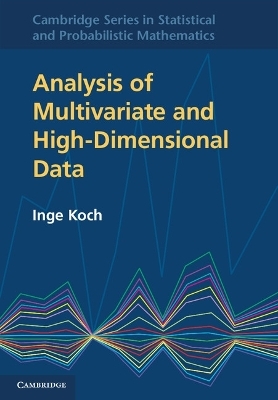
Analysis of Multivariate and High-Dimensional Data
Seiten
2013
Cambridge University Press (Verlag)
978-0-521-88793-9 (ISBN)
Cambridge University Press (Verlag)
978-0-521-88793-9 (ISBN)
'Big data' poses challenges that require both classical multivariate methods and modern machine-learning techniques. This coherent treatment integrates theory with data analysis, visualisation and interpretation of the analysis. Problems, data sets and MATLAB® code complete the package. It is suitable for master's/graduate students in statistics and working scientists in data-rich disciplines.
'Big data' poses challenges that require both classical multivariate methods and contemporary techniques from machine learning and engineering. This modern text equips you for the new world - integrating the old and the new, fusing theory and practice and bridging the gap to statistical learning. The theoretical framework includes formal statements that set out clearly the guaranteed 'safe operating zone' for the methods and allow you to assess whether data is in the zone, or near enough. Extensive examples showcase the strengths and limitations of different methods with small classical data, data from medicine, biology, marketing and finance, high-dimensional data from bioinformatics, functional data from proteomics, and simulated data. High-dimension low-sample-size data gets special attention. Several data sets are revisited repeatedly to allow comparison of methods. Generous use of colour, algorithms, Matlab code, and problem sets complete the package. Suitable for master's/graduate students in statistics and researchers in data-rich disciplines.
'Big data' poses challenges that require both classical multivariate methods and contemporary techniques from machine learning and engineering. This modern text equips you for the new world - integrating the old and the new, fusing theory and practice and bridging the gap to statistical learning. The theoretical framework includes formal statements that set out clearly the guaranteed 'safe operating zone' for the methods and allow you to assess whether data is in the zone, or near enough. Extensive examples showcase the strengths and limitations of different methods with small classical data, data from medicine, biology, marketing and finance, high-dimensional data from bioinformatics, functional data from proteomics, and simulated data. High-dimension low-sample-size data gets special attention. Several data sets are revisited repeatedly to allow comparison of methods. Generous use of colour, algorithms, Matlab code, and problem sets complete the package. Suitable for master's/graduate students in statistics and researchers in data-rich disciplines.
Inge Koch is Associate Professor of Statistics at the University of Adelaide, Australia.
Part I. Classical Methods: 1. Multidimensional data; 2. Principal component analysis; 3. Canonical correlation analysis; 4. Discriminant analysis; Part II. Factors and Groupings: 5. Norms, proximities, features, and dualities; 6. Cluster analysis; 7. Factor analysis; 8. Multidimensional scaling; Part III. Non-Gaussian Analysis: 9. Towards non-Gaussianity; 10. Independent component analysis; 11. Projection pursuit; 12. Kernel and more independent component methods; 13. Feature selection and principal component analysis revisited; Index.
| Erscheint lt. Verlag | 2.12.2013 |
|---|---|
| Reihe/Serie | Cambridge Series in Statistical and Probabilistic Mathematics |
| Zusatzinfo | Worked examples or Exercises; 76 Tables, unspecified; 98 Plates, color; 1 Halftones, unspecified; 4 Line drawings, unspecified |
| Verlagsort | Cambridge |
| Sprache | englisch |
| Maße | 182 x 260 mm |
| Gewicht | 1290 g |
| Themenwelt | Mathematik / Informatik ► Mathematik ► Statistik |
| ISBN-10 | 0-521-88793-3 / 0521887933 |
| ISBN-13 | 978-0-521-88793-9 / 9780521887939 |
| Zustand | Neuware |
| Haben Sie eine Frage zum Produkt? |
Mehr entdecken
aus dem Bereich
aus dem Bereich
Eine Einführung für Wirtschafts- und Sozialwissenschaftler
Buch | Softcover (2022)
De Gruyter Oldenbourg (Verlag)
29,95 €


